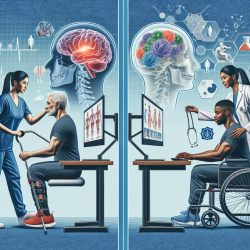Enhancing Practitioner Skills Through NIH Rehabilitation Research

The National Institutes of Health (NIH) has long been a pioneer in rehabilitation research, dedicating over $500 million annually across 17 institutes and centers. The comprehensive research findings from the NIH, as summarized in the article "Rehabilitation Research at the National Institutes of Health: Moving the Field Forward," offer invaluable insights for practitioners aiming to enhance their skills and improve patient outcomes. Here, we explore key takeaways and practical applications for practitioners in the field of rehabilitation.
Key Research Outcomes and Their Applications
Integrating Rehabilitation Across the Lifespan
The research emphasizes the importance of moving from a "one-and-done" model to integrating rehabilitation into mainstream healthcare. Practitioners can apply this by:
- Adopting collaborative care approaches, such as telecare, for conditions like cancer and chronic illnesses.
- Developing integrated care paradigms between primary and rehabilitative care providers to prevent mobility decline in older adults.
- Focusing on long-term pediatric rehabilitation for conditions like traumatic brain injury (TBI) to address lifelong consequences.
Leveraging Technology in Rehabilitation
Advancements in engineering and computing have made technology an essential component of rehabilitation. Practitioners should consider:
- Using neuroprostheses and other assistive devices to enhance patient-specific care.
- Incorporating virtual reality environments and mobile health platforms for therapy deployment.
- Engaging with regulatory bodies early in the development of new technologies to ensure safety and efficacy.
Understanding Mechanisms and Markers of Activity and Function
The research highlights the need for better characterization of patient populations and monitoring tools. Practitioners can:
- Use advanced imaging methods to capture clinically relevant muscle performance metrics.
- Integrate stress management training with standard rehabilitation programs to improve outcomes.
- Focus on the physiological profiles of patients to identify responders versus non-responders.
Enhancing Access to the Lived Environment
Assistive technologies (ATs) can significantly improve functional independence. Practitioners should:
- Include individuals with disabilities in all stages of research to ensure content validity.
- Focus on utility measures like task performance, user satisfaction, and quality of life.
- Ensure ATs are sustainable, accessible, and affordable to the populations in need.
Promoting Family and Community Involvement
Rehabilitation interventions that incorporate the home, family, and community can enhance patient engagement. Practitioners can:
- Support family caregivers with technology-based interventions to reduce caregiver burden.
- Develop self-management strategies for individuals to maintain positive outcomes.
- Consider sociodemographic influences on rehabilitation success and tailor interventions accordingly.
Encouraging Further Research
The NIH's comprehensive approach to rehabilitation research underscores the importance of ongoing investigation and adaptation. Practitioners are encouraged to:
- Engage in participatory action research to address diverse patient needs.
- Explore alternative methodologies beyond randomized controlled trials to find cost-effective solutions.
- Collaborate across disciplines to enhance the impact of rehabilitation interventions.
By integrating these research outcomes into practice, rehabilitation professionals can significantly enhance their skills and improve patient care. To read the original research paper, please follow this link:
Rehabilitation Research at the National Institutes of Health:
Citation: Frontera, W. R., Bean, J. F., Damiano, D., Ehrlich-Jones, L., Fried-Oken, M., Jette, A., Jung, R., Lieber, R. L., Malec, J. F., Mueller, M. J., Ottenbacher, K. J., Tansey, K. E., & Thompson, A. (2017). Rehabilitation Research at the National Institutes of Health: Moving the Field Forward (Executive Summary). Physical Therapy, 97(4), 393-403. https://doi.org/10.1093/ptj/pzx027










